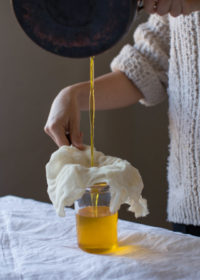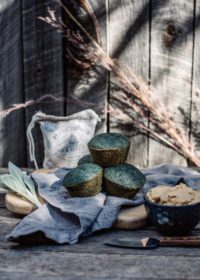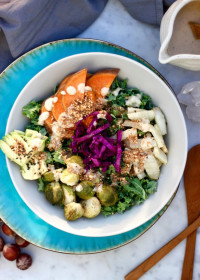Recipes: Morel Mushroom & Butternut Squash Pasta
![]()
 I’ve been a bit seasonally confused lately. I left the cold Midwest winter last month and landed in Kauai on my birthday. It’s been an incredible month settling into the island and receiving her many blessings, including the abundance of gorgeous produce here. Saturday markets are filled with fruits and vegetables I’d never heard of before…soursop, egg fruit, bread fruit, longons, and over 80 varieties of avocados that I’m tasting my through. Heaven is real!
I’ve been a bit seasonally confused lately. I left the cold Midwest winter last month and landed in Kauai on my birthday. It’s been an incredible month settling into the island and receiving her many blessings, including the abundance of gorgeous produce here. Saturday markets are filled with fruits and vegetables I’d never heard of before…soursop, egg fruit, bread fruit, longons, and over 80 varieties of avocados that I’m tasting my through. Heaven is real!
Before I left Oklahoma, I got a chance to dig into some new cold weather recipe testing for Edible Magazine (my photo even made this month’s magazine cover feature, check it out below!). With this issue’s focus on foraging, I decided to experiment with some local edibles and ways to use these foraged gifts in wintertime when very little seems to come from the local land. Morel mushrooms are one of those local gifts that come in spring and many dry and store for the sparse months to spruce up their dishes. There’s a fairly short window for foraging morels in Oklahoma from late-March to late-April, and those who know where to look hold their secret spots near and dear to their hearts. Some families have even been harvesting in the same location for generations. If you’re new to hunting morels, make friends with a forager who knows mycology. It’s important to be 100% certain what you’re harvesting is what you think it is. They say there’s no such thing as both an old and bold forager!
There’s a fairly short window for foraging morels in Oklahoma from late-March to late-April, and those who know where to look hold their secret spots near and dear to their hearts. Some families have even been harvesting in the same location for generations. If you’re new to hunting morels, make friends with a forager who knows mycology. It’s important to be 100% certain what you’re harvesting is what you think it is. They say there’s no such thing as both an old and bold forager!
 Morels can be identified by their distinct tall cap, creamy color and hollow interiors. These mushrooms commonly live on the edge of forested areas, usually near ash, aspen, elm and oak trees. Locals often say it is morel season when the Red Bud trees start to bloom. You’ll often find the first morels of the year when daytime highs reach the 60s and lows stay above 40 degrees.
Morels can be identified by their distinct tall cap, creamy color and hollow interiors. These mushrooms commonly live on the edge of forested areas, usually near ash, aspen, elm and oak trees. Locals often say it is morel season when the Red Bud trees start to bloom. You’ll often find the first morels of the year when daytime highs reach the 60s and lows stay above 40 degrees.
 Once harvested, soak the mushrooms in water for several hours to clean them. Use fresh for this pasta recipe in spring, or dry them completely and store sealed in an airtight jar to enjoy them outside of the harvest season. By deep winter, they are a wonderful treat to rehydrate and cook alongside hearty winter greens and root veggies. Note: If you can’t snag morels from a friend or find them in your local area, chanterelles make wonderful substitutes for this dish as well!
Once harvested, soak the mushrooms in water for several hours to clean them. Use fresh for this pasta recipe in spring, or dry them completely and store sealed in an airtight jar to enjoy them outside of the harvest season. By deep winter, they are a wonderful treat to rehydrate and cook alongside hearty winter greens and root veggies. Note: If you can’t snag morels from a friend or find them in your local area, chanterelles make wonderful substitutes for this dish as well!
 MOREL MUSHROOM & BUTTERNUT SQUASH PASTA
MOREL MUSHROOM & BUTTERNUT SQUASH PASTA
1 small butternut squash, peeled & deseeded
3 tbsp ghee or olive oil
2 large shallots, sliced
4 cloves garlic, minced
1 cup morel mushrooms, rehydrated & sliced thinly
1 tsp coconut sugar
¼ tsp sea salt
4 tbsp sage, minced
1 tbsp lemon zest
1 cup kale, chiffonade cut
cracked black pepper
Preheat the oven to 375F.
If using dried morel mushrooms, place them in a bowl and cover with warm water to rehydrate. Once soft, drain and rinse well. Slice into thin 1/4-inch slices and set aside until ready to use.
Next, heat the ghee or oil in a large skillet on medium heat. Add the shallots and cooked until lightly translucent, about 1-2 minutes. Then, add the garlic and reduce heat to low. Allow these to slowly cook until a light golden color before adding the mushrooms. Stir in the sliced mushrooms and coconut sugar. Continue to stir and cook until lightly caramelized. Add in the sage and salt, and continue to cook for 1-2 minutes. Last, stir in the lemon zest and add the thinly sliced kale, stir until greens lightly wilt. Remove from heat, cover with lid and set aside while cooking the pasta.
Using a vegetable spiralizer, process the prepared squash through the machine to create long noodles. Place in a bowl and toss with olive oil, salt and pepper. Spread evenly across a baking sheet, and place in oven to cook for 15 minutes, or until lightly tender but not too soft. Remove from oven and plate the pasta while hot, adding the sautéed mushrooms and kale mixture on top and a dallop of pesto to each prepared plate or bowl. Season with a salt and pepper to taste.
Makes 4 servings
Dandelion Pesto
1 cup dandelion leaves
1 cup spinach leaves
½ cup parsley
½ cup basil
2 small cloves garlic
½ tsp salt
1 tsp lemon juice
¼ cup olive oil
Combine all ingredients, except the oil, in a food processor or blender. Pulse until well combined. Add the oil and pulse again. Transfer to an airtight glass container and store in your fridge until ready to use.
Makes roughly 1 cup
 [wpmenucart]
[wpmenucart] Living Ayurveda: Making Ghee
Living Ayurveda: Making Ghee  Recipes: Taos Blue Corn Muffins + Taos Retreat
Recipes: Taos Blue Corn Muffins + Taos Retreat  Recipes: Winter Bowl with Dukkah + Tahini Dressing from Hearty Bite
Recipes: Winter Bowl with Dukkah + Tahini Dressing from Hearty Bite 